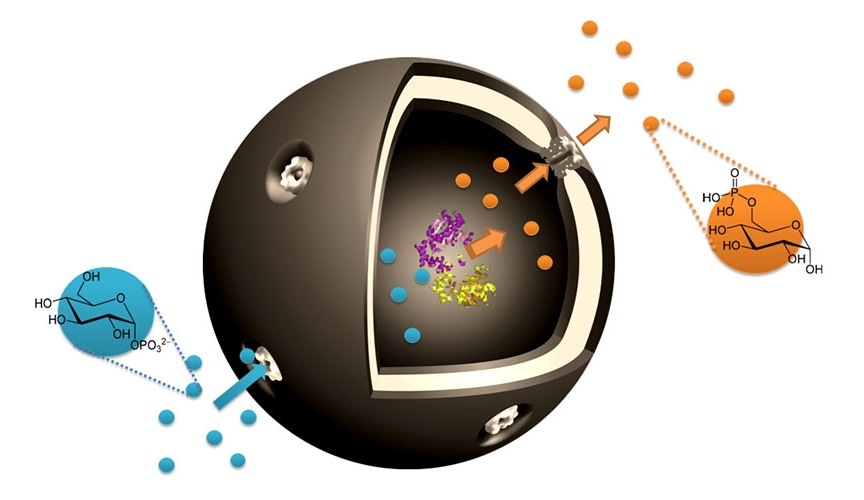Sep 20 2017
Capsules capable of generating the bio-molecule glucose-6-phosphate that plays a vital role in metabolic processes have been successfully developed by Researchers at the University of Basel. These Researchers produced the metabolite in conditions extremely similar to the biochemical reaction inside natural cells. The findings have been published in Chemical Communications, a scientific journal.
 Schematic illustration of the bio-catalytic nanocompartment with encapsulated enzyme phosphoglucomutase for the conversion of glucose-1-phosphate (blue circles) into the desired product glucose-6-phosphate (orange circles). Credit: University of Basel
Schematic illustration of the bio-catalytic nanocompartment with encapsulated enzyme phosphoglucomutase for the conversion of glucose-1-phosphate (blue circles) into the desired product glucose-6-phosphate (orange circles). Credit: University of Basel
Metabolic processes within living organisms include a wide range of bio-molecules. These molecules are developed by particular enzymatic reactions. Glucose-6-phosphate is one example of such a bio-molecule that is referred to as a metabolite involved in vital metabolic processes. It plays a central role in the degradation of carbohydrates and can also be transformed further into particular molecules responsible for storing energy within an organism. If such bio-molecules can be developed directly inside living cells, it would indeed make way for new perspectives in the treatment of disease.
Nanocapsules produce glucose-6-phosphate
Researchers headed by Professor Cornelia Palivan from the Department of Chemistry at the University of Basel have designed bio-catalytic capsules containing the active enzyme phosphoglucomutase and capable of producing and releasing glucose-6-phosphate.
To begin the reaction, the substrate needed for the reaction has to be capable of entering the capsule. Thus, a pore protein synthesized at ETH Zurich was inserted by the Researchers in the walls of the capsules. These pores are treated to be the entry door for the substrate and the exit for the product glucose-6-phosphate, while the enzyme continues to be encapsulated and protected against degradation.
The developed nanocapsules are less than 200 nm in size, meaning they can be taken up by cells, a vital prerequisite for testing and application conducted in the future.
The Researchers built their capsules in conditions extremely similar to those in nature, unlike other approaches that use organic solvents.
Our approach is always to be as nature-like as possible, so we can preserve the intrinsic bio-functionality of the enzymes and pore proteins.
Professor Cornelia Palivan, the Department of Chemistry, the University of Basel
Going forward, the Researchers plan to test the capsules on cells in order to see if they are taken up and then generate glucose-6-phosphate within the cell.